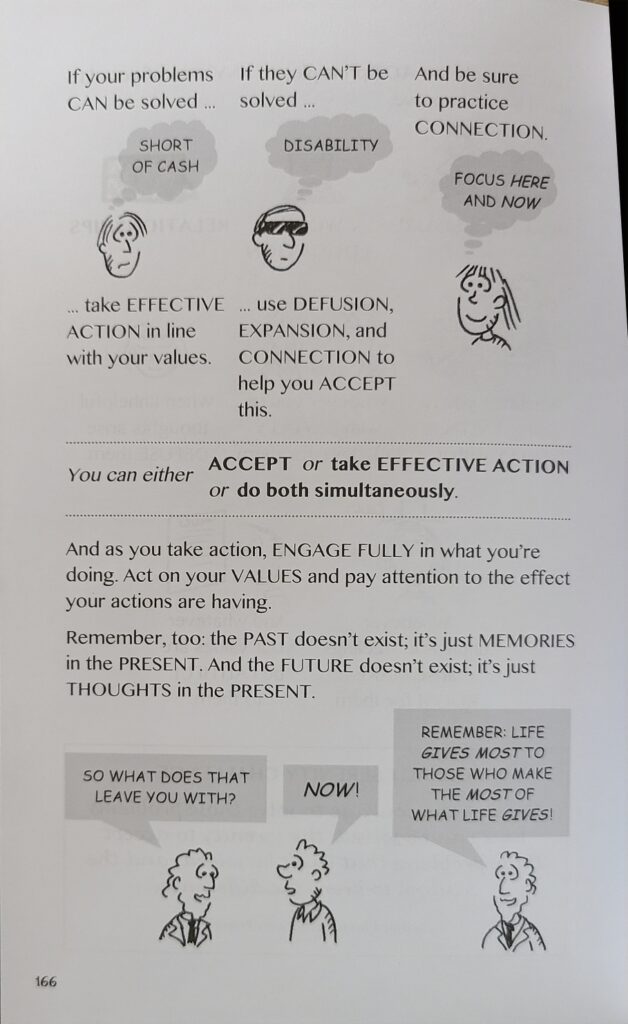 The Illustrated Happiness Trap: How to Stop Struggling and Start Living by Russ Harris
The Illustrated Happiness Trap: How to Stop Struggling and Start Living by Russ HarrisMy rating: 4 of 5 stars
Good intro to ACT. Read the book in a single setting. Useful format.
View all my reviews
Develop the courage to solve those problems that can be solved, the serenity to accept those problems that can’t be solved, and the wisdom to know the difference.
The ACT Serenity Chalenge
Book Notes
- Dispelling Myths
- Happiness is the natural state for human beings.
- If you’re not happy, you’re defective.
- ACT Principle: The normal thinking processes of a healthy mind naturally create psychological suffering.
- To create a better life, we must get rid of negative feelings.
- Connect to Daylio.
- You should be able able to control what you think and feel.
- Mechanisms to Cope with painful thoughts and feelings:
- Fight:
- Suppression
- Arguing with yourself
- Taking charge (top-down regulation)
- Self-bullying
- Flight:
- Avoidance/hiding/escaping
- Distraction
- Zoning out/numbing
- Substance abuse
- Fight:
- Challenging traditional advice:
- Check the facts and correct mental errors
- Make the story more positive
- Tell yourself a better story
- Distract yourself
- Push the story away
- Debate the truth of the story
- According to ACt, the strategies above rarely work in the long run (goes against CBT). “Negative stories aren’t the problem! The problem is getting caught up in them and letting them dictate your actions.”
| Fusion: | Connection: |
| Distracted | Engaged |
| Judgemental | Defused from judgments |
| Easily bored, knows it all | Curious |
| Past or future | Present |
| Closed off | Open |
| Thinking self struggles against reality | Observing self notices and opens to reality |
If I let this thought guide what I do, will it help me create the life I want?
- Is being one with your thoughts ever helpful? (i.e. is fusion ever helpful?)
- “It can be. Planning your future, mentally rehearsing your actions, getting lost in a book, can all be helpful types of fusion.”
- Our mind is a bit like a Radio Doom & Gloom.
- If it’s broadcasting a helpful story, tune in, and let it guide your actions.
- If it’s broadcasting something unhelpful, then just let chatter away in the background.
- It doesn’t make sense to argue with the radio.
- “But though you may not have direct control over your feelings, you can directly control your actions. The idea that emotions control actions is a powerful illusion.“
- The three phases of emotion creation:
- A significant event occurs either internally (a thought) or externally.
- Your brain registers the event as important (connected to salience, dopamine, and prediction error).
- Your brain evaluates the situation and prepares you for appropriate action.
- Good or bad? Interoception and valence. Vipassana’s concept of craving and aversion.
- Stay or go? Fight or flight response.
- The mind tells a story about the experience which others may or may not agree with.
- Closely related to How Emotions Are Made. Lisa would argue that the brain doesn’t react to an event but rather makes predictions. I think she would agree that emotions are similar to a story.
- Emotions arise from physical changes in the body.
- A significant event occurs either internally (a thought) or externally.
- NOTE: Mindful breathing is NOT a relaxation technique or a way to avoid feelings. It’s an anchor to hold steady in the midst of an emotional storm.
- Even one slow deep breath can help to anchor you until the storm passes.
To create a rich and full life we need to act on our values.
The two essentials for making life rich, full, and meaningful:
- Engage mindfully in whatever you’re doing.
- Make sure what you’re doing is meaningful.
| Values: | Goals: |
| A direction you want to keep moving in | Something you want to get, have, own, or achieve. |
| An ongoing process with no end | Can be “ticked off the list” |
- What do you really want in life?
- To be happy, to be rich, to be successful, a great job, someone to love me, to marry and have kids.
- These are not values. They are goals.
| Health physical, psychological, and spiritual | Leisure fun, games, relaxation, sports, hobbies, creativity |
| Work/Education includes unpaid wok, apprenticeships, and self-education (reading books) | Relationships friends, family, coworkers, neighbors, etc. |
Five steps to set up meaningful goals:
- Summarize your top values in a specific domain
- Set an immediate goal:
- Easy, simple, specific enough to be able to get done today.
- Set some short-term goals – week
- Medium-term goals – months ish
- Long-term goals – years
- The downside of goals:
- We have a choice:
- to find meaning, where and now, by living by your values.
- OR
- To be miserable by focusing on a goal you haven’t achieved yet.
- to find meaning, where and now, by living by your values.
- We have a choice:


Read This Next
- Pathological Productivity
- Life is a Jar
- Atomic Habits Book Review
- My 10-day Vipassana Silent Retreat Experience
- Cal Newport Was Wrong
- What I Learned from Tracking my Mood for 1000 days
- The Do-Nothing Morning Routine Experiment
- Automate Your Finances
- Deep Work – Book Notes
- Looking Back On My 2-Month Podfast
- The Parallel Universes of Time and Money
Affiliate Links
- The Illustrated Happiness Trap – Russ Harris
- How Emotions Are Made – Lisa Feldman Barrett
- The Molecule of More – Daniel Z. Lieberman & Michael E. Long
- Stumbling on Happiness – Daniel Gilbert
- Four Thousand Weeks – Oliver Burkeman
- Solve for Happy – Mo Gawdat
- Hunter-Gatherer’s Guide to the 21st Century – Heather Heying & Bret Weinstein
- How to Live on 24 Hours a Day – Arnold Bennett
- Tao Te Ching – Lao Tzu (Translated by Stephen Mitchell)
- Siddhartha – Herman Hesse
- Walking – Erling Kagge
- Silence – Erling Kagge
- Atomic Habits – James Clear
- Stillness is the Key – Ryan Holiday
